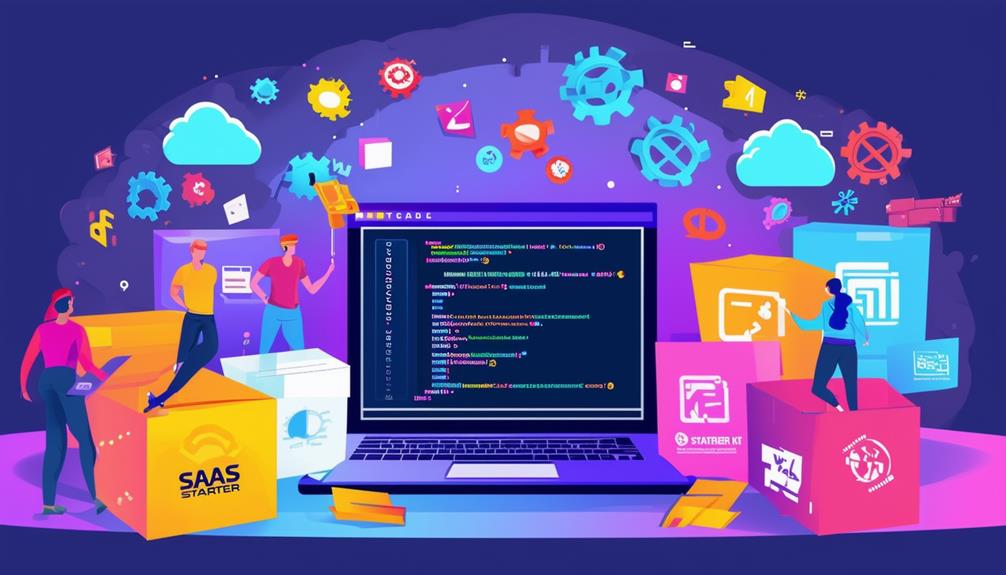When you use SaaS boilerplates, you’re not just saving time; you’re actively enhancing your code quality. These frameworks provide a standardized structure that minimizes errors and promotes the reuse of components, ensuring your code is both efficient and reliable. By following established best practices, you make maintenance and scalability much easier down the line. And with automated testing integrated into the process, you can catch issues before they become problems. But how do these elements really come together to shape the development process?
Standardized Code Structure
A standardized code structure not only streamlines development but also enhances collaboration among team members, making it easier for everyone to understand and contribute to the project. When you adopt a consistent format, you eliminate confusion and reduce onboarding time for new developers. They’ll quickly grasp the layout, naming conventions, and file organization, allowing them to immerse themselves and start contributing almost immediately.
Additionally, a standardized approach reduces the likelihood of errors. When everyone follows the same guidelines, code reviews become more efficient, as reviewers can focus on functionality rather than deciphering different styles. This uniformity also aids in debugging; when issues arise, you’ll find it easier to pinpoint problems in a cohesive codebase.
Moreover, maintaining and scaling your project becomes considerably less intimidating. As the code grows, a consistent structure helps you manage complexity, ensuring that features can be added without hindrance. You’ll find it easier to implement changes or troubleshoot issues, which ultimately leads to higher quality code.
In short, a standardized code structure lays a solid foundation for your SaaS project, fostering better teamwork and enhancing overall code quality.
Reusable Components
Reusable components play an essential role in enhancing efficiency and consistency across your SaaS application, allowing you to build features faster and with less redundancy. By creating modular elements like buttons, forms, and navigation bars, you streamline your development process. This means you won’t have to write the same code multiple times; instead, you can just plug in your pre-built components wherever needed.
Using reusable components not only saves time but also improves your code quality. Since these components are tested and optimized, you reduce the likelihood of bugs and inconsistencies in your application. When you make changes to a reusable component, those changes automatically propagate throughout your application, ensuring uniformity.
Moreover, reusable components promote a more maintainable codebase. When you or your team needs to update a feature, you can do so in a single location rather than hunting down every instance of that code. This makes onboarding new developers easier, as they can quickly understand and utilize the established components without wading through repetitive code.
Incorporating reusable components into your SaaS boilerplate is a smart strategy that boosts productivity and enhances overall code quality.
Best Practices and Guidelines
To guarantee your SaaS boilerplate remains efficient and maintainable, it’s crucial to follow best practices and guidelines during development.
Start by establishing a clear folder structure. This organization helps team members quickly locate files and understand the project layout.
Next, prioritize code modularity. Break down your application into smaller, reusable components. This way, you can easily update or replace parts without affecting the entire system. Consistent naming conventions also enhance readability, so adopt a style guide and stick to it across your codebase.
Documentation is key, too. Don’t just comment on complex code; maintain up-to-date documentation for your entire project. This makes onboarding new team members smoother and reduces reliance on individual knowledge.
Additionally, embrace version control. Use Git or similar tools to manage changes, allowing you to track modifications and collaborate effectively.
Automated Testing Integration
Integrating automated testing into your SaaS boilerplate guarantees that your code remains reliable and bugs are caught early in the development process. This proactive approach allows you to identify issues before they escalate, saving you time and resources in the long run.
When you include automated tests, you set up a safety net for your code. Every time you make changes, these tests run automatically, ensuring that existing functionality isn’t broken. This continuous feedback loop helps you maintain high code quality throughout the development lifecycle.
Moreover, automated testing encourages better coding practices. Knowing that your code will be tested means you’re more likely to write cleaner, more efficient code. You’ll find that writing tests first (a practice known as Test-Driven Development) can lead to more thoughtful design decisions, ultimately leading to a more robust application.
With dedicated testing frameworks and tools available, integrating automated testing into your SaaS boilerplate is easier than ever. Embracing this practice not only boosts your code quality but also enhances your team’s confidence, allowing you to innovate and iterate faster without sacrificing reliability.
Enhanced Collaboration
Automated testing not only improves code quality but also fosters enhanced collaboration among team members, as everyone can confidently contribute knowing the code base is stable.
When you implement a SaaS boilerplate, it sets a clear structure and standard for your project, allowing developers to work in tandem without stepping on each other’s toes.
With a consistent environment and established coding practices, you can quickly onboard new team members, reducing the learning curve and ensuring they’re productive right from the start. This shared understanding helps you communicate more effectively, as everyone is on the same page regarding project goals and expectations.
Moreover, automated tests serve as a safety net. If you or a colleague make changes, you can run these tests to confirm that nothing’s broken. This encourages experimentation and innovation, knowing the risks are minimized.
As a result, you’ll see increased trust and camaraderie within your team. When everyone feels secure in their contributions, collaboration flourishes, leading to faster problem-solving and ultimately a better product.
Enhanced collaboration is a key benefit of using SaaS boilerplates that directly impacts your project’s success.
Reduced Technical Debt
How can reducing technical debt improve your SaaS project’s longevity and maintainability?
By leveraging SaaS boilerplates, you can streamline your development process and minimize the accumulation of technical debt. When you start with a well-structured boilerplate, you’re laying a solid foundation that adheres to best practices, making it easier to implement new features and fix bugs without compromising code quality.
As you build upon a proven framework, you avoid the pitfalls of ad-hoc coding solutions that often lead to messy, tangled code. This clarity not only enhances your team’s productivity but also makes onboarding new developers simpler. They can quickly understand the architecture and design patterns, reducing the friction often experienced with legacy systems.
Moreover, as you minimize technical debt, you enhance your project’s maintainability. You’ll find it easier to adapt to changing requirements, ensuring that your SaaS product remains relevant in a fast-paced market.
Ultimately, by reducing technical debt, you’re investing in your project’s future, allowing for smoother updates and scalability, which keeps your users satisfied and engaged.
To Wrap Up
Incorporating SaaS boilerplates into your development process can greatly boost your code quality.
By providing a standardized structure, promoting reusable components, and encouraging best practices, these tools streamline your workflow and reduce errors.
The integration of automated testing not only enhances reliability but also fosters a culture of thoughtful coding.
Ultimately, adopting boilerplates leads to better collaboration and minimizes technical debt, allowing you to focus on building robust applications that stand the test of time.






